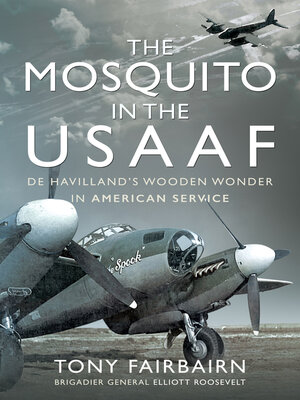The Mosquito in the USAAF
ebook ∣ De Havilland's Wooden Wonder in American Service
By Tony Fairbairn

Sign up to save your library
With an OverDrive account, you can save your favorite libraries for at-a-glance information about availability. Find out more about OverDrive accounts.
Find this title in Libby, the library reading app by OverDrive.



Search for a digital library with this title
Title found at these libraries:
| Loading... |
This history of the US's British aircraft acquisition "examin[es] the role [the USSAF] played in reconnaissance, special operations, and night fighting." —Air & Space Power History
On 20 April 1941, a group of distinguished Americans visited the de Havilland Aircraft Company's airfield at Hatfield, England. The party was there ostensibly to gain an insight into how various US aircraft supplied to Britain were performing, as well as to observe some of the latest British products being put through their paces. The eighteen types on display included both US and British bombers and fighters. But the star of the day was undoubtedly the de Havilland Mosquito.
Having first flown only a few months earlier, the aircraft was demonstrated by none other than Geoffrey de Havilland. Striving to impress the trans-Atlantic visitors, de Havilland provided an outstanding display of speed and manoeuvrability. It was a routine that left the Americans in no doubt as to the Mosquito's abilities.
Following America's entry into WWII, formal requests for Mosquitoes began in earnest. A steady flow of the photographic reconnaissance version were provided to what would become the USAAF's 25th Bomb Group at Watton, England. There they served with distinction in a variety of specialist roles. A number of these Mosquitoes served with the 492nd Bomb Group at Harrington and were involved in the so-called "Joan-Eleanor" project. Finally, in 1945, the USAAF received much-anticipated night fighter Mosquitoes which enjoyed combat success with the 416th Night Fighter Squadron in Italy.
In this highly illustrated work, the author explores the full story of why the Americans wanted Mosquitoes, how they went about obtaining them, and their noted success and popularity with USAAF units.
On 20 April 1941, a group of distinguished Americans visited the de Havilland Aircraft Company's airfield at Hatfield, England. The party was there ostensibly to gain an insight into how various US aircraft supplied to Britain were performing, as well as to observe some of the latest British products being put through their paces. The eighteen types on display included both US and British bombers and fighters. But the star of the day was undoubtedly the de Havilland Mosquito.
Having first flown only a few months earlier, the aircraft was demonstrated by none other than Geoffrey de Havilland. Striving to impress the trans-Atlantic visitors, de Havilland provided an outstanding display of speed and manoeuvrability. It was a routine that left the Americans in no doubt as to the Mosquito's abilities.
Following America's entry into WWII, formal requests for Mosquitoes began in earnest. A steady flow of the photographic reconnaissance version were provided to what would become the USAAF's 25th Bomb Group at Watton, England. There they served with distinction in a variety of specialist roles. A number of these Mosquitoes served with the 492nd Bomb Group at Harrington and were involved in the so-called "Joan-Eleanor" project. Finally, in 1945, the USAAF received much-anticipated night fighter Mosquitoes which enjoyed combat success with the 416th Night Fighter Squadron in Italy.
In this highly illustrated work, the author explores the full story of why the Americans wanted Mosquitoes, how they went about obtaining them, and their noted success and popularity with USAAF units.






